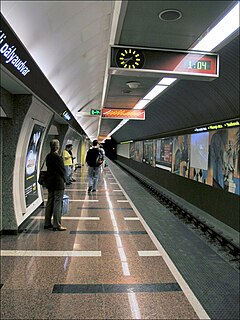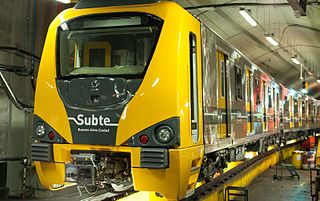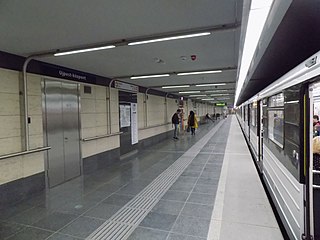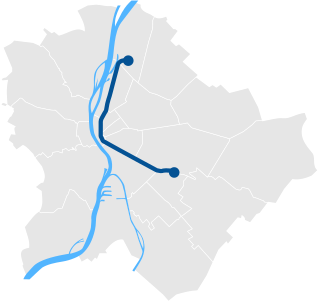| Line 2 | |||
|---|---|---|---|
 | |||
| Overview | |||
| Type | Rapid transit | ||
| System | Budapest Metro | ||
| Status | Operational | ||
| Termini | Déli pályaudvar Örs vezér tere | ||
| Stations | 11 | ||
| Line number | Line 2 ("Red metro") | ||
| Operation | |||
| Opened | April 2, 1970 | ||
| Operator(s) | BKV | ||
| Technical | |||
| Line length | 10.3 km (6 mi) [1] | ||
| Track gauge | 1,435 mm (4 ft 8 1⁄2 in) | ||
| Electrification | 825 V DC | ||
| Operating speed | 70 km/h [1] | ||
| |||
| Metro 2 | |||||||||||||||||||||||||||||||||||||||||||||||||||||||||||||||||||||||||||||||||||||||||||||||||||||||||||||||||||||||||||||||||||||||||||||||||||||||||||||||||||||||||||||||||||||||||||||||||||||||||||||||||||||||||||||||||||||||||||||||||||||||||||||||||||||||||||||||
|---|---|---|---|---|---|---|---|---|---|---|---|---|---|---|---|---|---|---|---|---|---|---|---|---|---|---|---|---|---|---|---|---|---|---|---|---|---|---|---|---|---|---|---|---|---|---|---|---|---|---|---|---|---|---|---|---|---|---|---|---|---|---|---|---|---|---|---|---|---|---|---|---|---|---|---|---|---|---|---|---|---|---|---|---|---|---|---|---|---|---|---|---|---|---|---|---|---|---|---|---|---|---|---|---|---|---|---|---|---|---|---|---|---|---|---|---|---|---|---|---|---|---|---|---|---|---|---|---|---|---|---|---|---|---|---|---|---|---|---|---|---|---|---|---|---|---|---|---|---|---|---|---|---|---|---|---|---|---|---|---|---|---|---|---|---|---|---|---|---|---|---|---|---|---|---|---|---|---|---|---|---|---|---|---|---|---|---|---|---|---|---|---|---|---|---|---|---|---|---|---|---|---|---|---|---|---|---|---|---|---|---|---|---|---|---|---|---|---|---|---|---|---|---|---|---|---|---|---|---|---|---|---|---|---|---|---|---|---|---|---|---|---|---|---|---|---|---|---|---|---|---|---|---|---|---|---|---|---|---|---|---|---|---|---|---|---|---|---|---|---|---|
| |||||||||||||||||||||||||||||||||||||||||||||||||||||||||||||||||||||||||||||||||||||||||||||||||||||||||||||||||||||||||||||||||||||||||||||||||||||||||||||||||||||||||||||||||||||||||||||||||||||||||||||||||||||||||||||||||||||||||||||||||||||||||||||||||||||||||||||||
Line 2 (officially: East-West Line, Metro 2 or M2, and unofficially: Red Line) is the second line of the Budapest Metro. The line runs east from Déli pályaudvar in north-central Buda under the Danube to the city center, from where it continues east following the route of Rákóczi út to its terminus at Örs vezér tere.

The Budapest Metro is the rapid transit system in the Hungarian capital Budapest. It is the oldest electrified underground railway system on the European continent, and the third-oldest electrically operated underground railway in the world, predated by the 1890 City & South London Railway and the Liverpool Overhead Railway in 1893-96. Its iconic Line 1 was completed in 1896.

Déli pályaudvar is the western terminus of the M2 (East-West) line of the Budapest Metro. It serves the Déli Railway Station and its vicinity.

The Danube is Europe's second longest river, after the Volga. It is located in Central and Eastern Europe.
Contents
Prior to the 2014 opening of Line 4, it was the only line that served Buda. Daily ridership is estimated at 451,627.







































